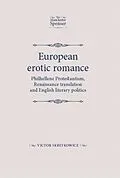European Erotic Romance examines the Renaissance publication and translation of the ancient Greek erotic romances, and English adaptations of the genre by Sir Philip Sidney, Shakespeare and Lady Mary Sidney Wroth. Providing fresh insight into the development of the novel, this study identifies the politicisation of erotic romance by the European philhellene (lovers of all things Greek) Protestant movement. To English translators and authors, the complex plots, well developed moralised characters (particularly female) and rhetorical styles of the ancient novels signify political and social reform. Generous quotation and translations ensure that European Erotic Romance is accessible to a broad spectrum of readers. Its organisation lends itself to use as a course text. It is suitable for use by senior undergraduates and specialists in Renaissance literature, translation, rhetoric and history.
Autorentext
Victor Skretkowicz
Inhalt
IntroductionPart One: Greco-Roman Romance in the Renaissance1 The Nature of Erotic RomanceGreco-Roman Romance of the Second Sophistic and the RenaissanceAphthonius, Philostratus, Ecphrasis and Artistic StyleCharacterisation: Theophrastus and PlutarchPhilhellenism and the Allegorical Politicisation of Erotic Romance2 Longus's Daphnis and Chloe The Novel as EcphrasisAmyot, Translation and the Kings of FranceReading, Education and TranslationTranslating Erotic RomanceAngel Day, The Shepheards Holidaie and Accession Day, 1587The Shepheards Holidaie, Court Drama, and Court PoetsTranslating Eros: Amyot, Day and ThornleyGeorge Thornley's ItchAngel Day and Dionysophanes' GardenThe End: Nothing But Shepherds' GamesConclusion3 Achilles Tatius's Leukippe and KleitophonRhetorics of Love European DisseminationBelleforest's FrenchBurton and the English PhilhellenesHodges, Erotic Arousal and Sidney's Arcadia Translating the OpeningEuropa: An EcphrasisEuropa and Apparent Cyclic FormKleitophon and CharacterisationKleitophon's Symbolic DreamKleinias on Love, Sex and MarriageKleitophon's GardenPantheia's DreamDebate on Erotic LoveSexual PredationMelite and ThersandrosThe Trial and ConclusionConclusion4 Heliodorus's An Ethiopian Story - Theagenes and Charikleia Charikliea: Royal FoundlingRenaissance Continental Translations and Philhellene PoliticsSandford's Historie of Chariclia and TheagenesUnderdowne's An Aethiopian HistorieFraunce, L'Isle and GoughExemplary Characters and Moral LessonsHeliodorus's Political RomanceHomeric BeginningsThe Insatiable DemaineteThyamis's Erotic DreamThyamis's Priestly FamilyRhodopis: Kalasiris's NightmareHeliodorus's Cyclic TalesLeadership and the LawThyamis JustifiedThe Wanton ArsakeThe Wicked KybeleRecognising CharikleiaLanguage and Nationalism L'Isle's Political PanegyricConclusionPart Two: Philhellene Erotic Romance 5 National Romance and Sidney's Arcadia Political Outlines Selective MonarchomachiaEvolution of ArcadiaUnfolding the Epic CycleSub-Plot and Exemplary CharacterPhilisides and Tiltyard Masquing Costume, Device, and Narrative StrategyPhiloclea's BedEroticising Renaissance RomanceErotic Romance and Erotic SexInterest Theory, Philhellene Politics, and Erotic RomanceThe Novel as Theatre Legal and Political Process as DramaThe End of RomanceConclusion6 Shakespeare and Philhellene Erotic Romance Shakespeare, Amyot and North's PlutarchAmyot-North Diction and Style in Coriolanus (1608)Julius Caesar (1599), Political Identifiers and the Rhetorics of Erotic RomanceAntony, Cleopatra, Octavius and the HuguenotsGreville's Antony and Cleopatra: Politics and Anti-RomancePanegyric in Antony and Cleopatra (1606): the Rewards of Patronage The Winter's Tale (1609-10): Exemplary RapprochementJealousy, Tyranny, and the Aggressive 'Royal' StyleGendering Rhetorics: Thucydides and the ErmineErotic ClosureCymbeline (1609-10), Rhetorical Style and the Catholic DisjunctionConclusion7 Mary Sidney Wroth's Urania Philhellene Protestant Erotic Propaganda Disjunction at the Throne of LoveA French StoryThe Dispossessed: Urania's MiseryTheatres of RomanceInterest Theory PersonalisedTechniques of ElisionAllegorical ParallelismUrania as Anti-RomanceThe Great Cham and His DynastyUrania as Roman à ClefThe Metamorphosis of Mary Sidney HerbertTruth and IllusionRodomandro's MasqueFemale Abuse and MartyrdomHereditary Succession and RestorationLiberation, Restoration and Marital UnionMeriana and the Macedonian SuccessionRomania AllegorisedClosing the Sophistic CircleUrania as Sophistic Erotic RomanceConclusionChapter 8The Fate of a GenreThe Semiotics of Erotic RomanceConclusionBibliographyIndex of Place-NamesGeneral Index
